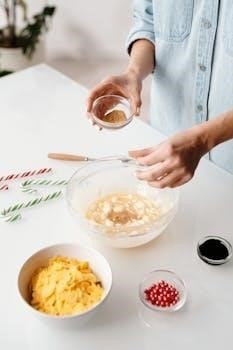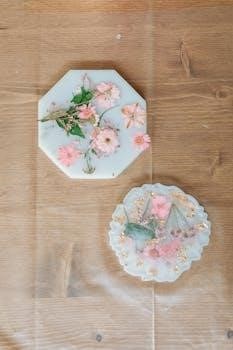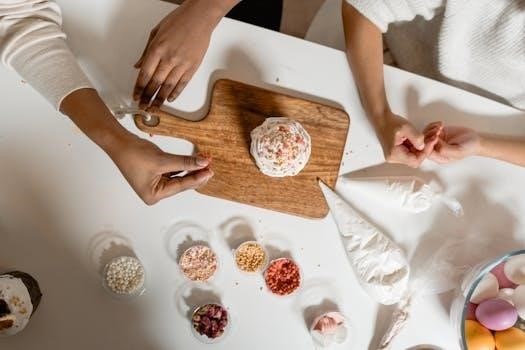Eye Candy pigments are metallic powders that don’t dissolve in resin but suspend, creating unique effects. These pigments are perfect for adding vibrant colors and a shimmering metallic finish to your epoxy resin projects.
What are Eye Candy Pigments?
Eye Candy pigments are a specialized type of colorant, primarily mica powders, renowned for their vibrant hues and ability to create stunning effects in epoxy resin. Unlike dyes, they don’t dissolve but rather suspend within the resin, resulting in a metallic or pearlescent shimmer. This unique characteristic allows for the creation of finishes similar to those seen in automotive paints. These pigments are available in a wide array of colors, including color-shifting varieties, offering endless creative possibilities. Eye Candy pigments are known for their high pigmentation, meaning a small amount goes a long way, ensuring that your resin projects achieve the desired intensity and depth of color. They are also very fine in particle size, which helps prevent clumping and ensures a smooth, even distribution within the resin. This makes them a popular choice for artists and crafters looking to add a touch of magic and brilliance to their work.

Safety Precautions When Using Pigments
When working with pigments, ensure proper ventilation and wear protective gear. Avoid skin contact and ingestion. Always read the manufacturer’s safety guidelines thoroughly before use.
Essential Safety Gear
Protecting yourself is paramount when working with epoxy resin and pigments. Always wear nitrile gloves to prevent skin contact with the resin and pigments, as some individuals may develop sensitivities. Safety glasses or goggles are crucial for shielding your eyes from splashes or airborne particles during mixing and pouring. A respirator mask rated for organic vapors is highly recommended to avoid inhaling fumes from the resin and any dust from the pigments. Working in a well-ventilated area is also essential, and a disposable apron or old clothing can prevent resin from damaging your good clothes. Consider using a designated work area where spills can be easily cleaned.

Preparing for Epoxy Resin Mixing
Before mixing, gather all your materials including resin, hardener, Eye Candy pigments, mixing cups, stir sticks, and your project molds. Ensure your workspace is clean and well-ventilated.
Gathering Necessary Supplies
To begin, you’ll need a high-quality epoxy resin kit, which includes both the resin and hardener components. Ensure you have the correct ratio for your specific brand, usually a 1⁚1 or 2⁚1 mix. Next, select your desired Eye Candy pigments, considering the color and finish you want to achieve. Gather mixing cups, and stir sticks for accurate measuring and mixing. You will also need a mold for your project, this could be a silicone coaster mold, a tumbler, or any other form you want to cast. Also, make sure you have gloves to protect your hands, and a drop cloth to prevent any resin spills.

Mixing Epoxy Resin with Eye Candy Pigments
Properly mixing epoxy resin with Eye Candy pigments is crucial for achieving vibrant and even color distribution. The process involves careful measurement and thorough blending of the components.
Choosing the Right Pigment Amount
Selecting the correct amount of Eye Candy pigment is vital for achieving the desired effect in your epoxy resin project. Too little pigment may result in a subtle or uneven color, while too much can lead to clumping or hinder the resin’s curing process. A good starting point is to use a small amount of pigment, gradually adding more until you reach the desired color intensity. Remember, Eye Candy pigments are highly concentrated, so a little goes a long way. Experimentation is key, and always refer to the specific product instructions for guidance on the recommended pigment-to-resin ratio. Begin with a small test batch to ensure you achieve your desired outcome without wasting materials. The goal is to find the perfect balance between color intensity and resin consistency, ensuring a smooth and even final product. It’s also important to note that different colors may require slightly different ratios due to variations in their pigment density.
Step-by-Step Mixing Instructions
Begin by carefully measuring your epoxy resin and hardener according to the manufacturer’s instructions. Once measured, combine the two parts in a clean mixing container; Gently stir the mixture, ensuring complete incorporation without creating excessive air bubbles. Next, add a small amount of your chosen Eye Candy pigment to the resin mixture. Stir thoroughly but slowly, until the pigment is evenly dispersed and no streaks remain. It’s crucial to mix well to avoid pigment clumping. If necessary, add a touch more pigment to reach the desired color. Continue stirring for a few minutes to ensure an even distribution. Pour the pigmented epoxy resin into your mold, or onto your chosen surface. Allow the epoxy to cure fully, according to the specific resin’s guidelines. This process will help achieve a beautiful, evenly colored finish. Always work in a well-ventilated area.

Achieving Different Effects with Eye Candy Pigments
Eye Candy pigments offer versatility in resin art. Experiment with different amounts for varied intensity, or combine colors to create unique, custom shades and shimmering, color-changing effects.
Creating Metallic Finishes
To achieve stunning metallic finishes with Eye Candy pigments, start by carefully measuring your epoxy resin and hardener. Next, add a small amount of your chosen Eye Candy metallic pigment to the resin, ensuring it is thoroughly mixed. The key to a good metallic finish is to ensure the pigment is completely dispersed, preventing clumps. Stir gently to avoid introducing bubbles. For deeper metallic tones, you can gradually add more pigment until the desired effect is reached. Remember, these pigments don’t dissolve but rather suspend, creating that characteristic metallic shimmer. The result is a beautiful, lustrous finish, similar to what you’d see on a high-end automotive paint job, giving your resin project a luxurious feel.
Using Color-Changing Mica Powders
Color-changing mica powders from Eye Candy Pigments offer a magical twist to epoxy resin projects. These powders shift colors depending on the viewing angle and light, adding depth and intrigue. When using them, mix the mica powder thoroughly into your resin, ensuring no clumps remain. Start with a small amount and add more gradually to reach your desired vibrancy and color-shift effect. The versatility of these powders allows for creative experimentation. Consider using a black base for the resin to amplify the color-changing effect. When using these powders in resin, safety should always be considered. This will help in achieving amazing effects in your projects.
Applications of Pigmented Epoxy Resin
Pigmented epoxy resin, enhanced with Eye Candy pigments, is perfect for crafting custom items like coasters and tumblers. The unique effects add a personal touch to any project.
Making Resin Coasters
Creating custom resin coasters is a fun project where Eye Candy pigments truly shine. Begin by gathering your supplies⁚ epoxy resin, hardener, molds, and your chosen Eye Candy pigments. Mix the resin and hardener according to the manufacturer’s instructions. Then, add your Eye Candy pigment, stirring gently to ensure even distribution. Pour the mixture into the molds, and let it cure. The metallic finish of Eye Candy pigments creates a beautiful, personalized touch. You can experiment with different colors and swirling techniques to achieve unique designs for each coaster. Eye Candy pigments suspend rather than dissolve, ensuring a striking, eye-catching effect perfect for these projects. This is a great way to add a bit of artistic flair to your home decor.
Creating Custom Tumblers
Customizing tumblers with epoxy resin and Eye Candy pigments allows you to create stunning, personalized drinkware. Start by prepping your tumbler, ensuring it’s clean and ready for the resin. Mix your epoxy resin and hardener carefully, following the correct ratio. Next, add your chosen Eye Candy pigment, stirring gently to avoid air bubbles. Apply the pigmented resin to the tumbler, rotating it to achieve even coverage. The vibrant, metallic effect of Eye Candy pigments will transform your tumbler into a unique piece of art. You can create swirls, gradients, or solid color designs. Allow the resin to cure completely, and you’ll have a custom tumbler with a dazzling finish. Eye Candy pigments make this a fun and creative project.
Troubleshooting Common Issues
When working with epoxy and Eye Candy pigments, clumping and uneven color distribution can occur. Proper mixing and pigment dispersion are key to avoid these problems and achieve desired results.
Preventing Pigment Clumping
To prevent pigment clumping when using Eye Candy pigments in epoxy resin, start by ensuring your pigments are finely ground. Adding the pigment to a small amount of resin first, and mixing thoroughly before adding to the larger batch, can help prevent clumping. It’s crucial to mix the resin and pigment carefully, ensuring even distribution, and using a gentle folding motion instead of whisking can help. Avoid adding too much pigment at once. Gradually introduce it to the resin for best results. Stir slowly to fully incorporate the pigment into the resin. If you notice clumps despite these efforts, use a fine mesh sieve to filter the mixture.
Addressing Uneven Color Distribution
Uneven color distribution when using Eye Candy pigments in epoxy resin can often be resolved with careful mixing techniques. Ensure the pigment is completely mixed into the resin by stirring slowly and thoroughly for several minutes. A lack of proper mixing will result in areas of highly pigmented resin beside areas where pigment is not well dispersed. To address this, use a flat mixing stick to scrape the bottom and sides of the container, ensuring no pigment is left unmixed. Pouring the resin slowly and evenly can also help achieve a uniform color. Check the consistency of the mixture before pouring, and if needed, remix to ensure color distribution is consistent.
